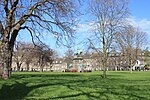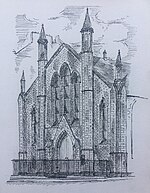St John's, Edinburgh
1818 establishments in Scotland19th-century Episcopal church buildings19th-century churches in the United Kingdom19th century in ScotlandCategory A listed buildings in Edinburgh ... and 4 more
Churches completed in 1818Episcopal church buildings in EdinburghListed churches in EdinburghUse British English from June 2017

The Church of St John the Evangelist is a Scottish Episcopal church in the centre of Edinburgh, Scotland. It is sited at the west end of Princes Street at its junction with Lothian Road, and is protected as a category A listed building.
Excerpt from the Wikipedia article St John's, Edinburgh (License: CC BY-SA 3.0, Authors, Images).St John's, Edinburgh
Lothian Road, City of Edinburgh Haymarket
Geographical coordinates (GPS) Address Website Nearby Places Show on map
Geographical coordinates (GPS)
| Latitude | Longitude |
|---|---|
| N 55.95 ° | E -3.2061 ° |
Address
The Red Cockerel
Lothian Road 1a
EH2 4BJ City of Edinburgh, Haymarket
Scotland, United Kingdom
Open on Google Maps











